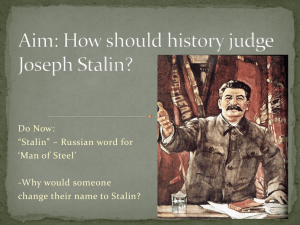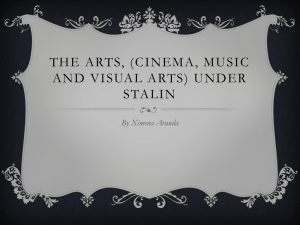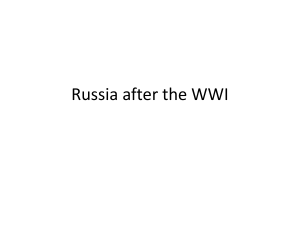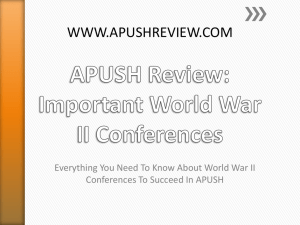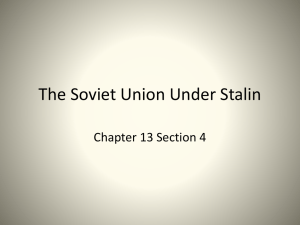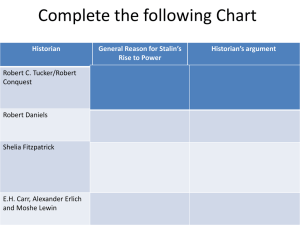Interwar USSR Student Intro
advertisement
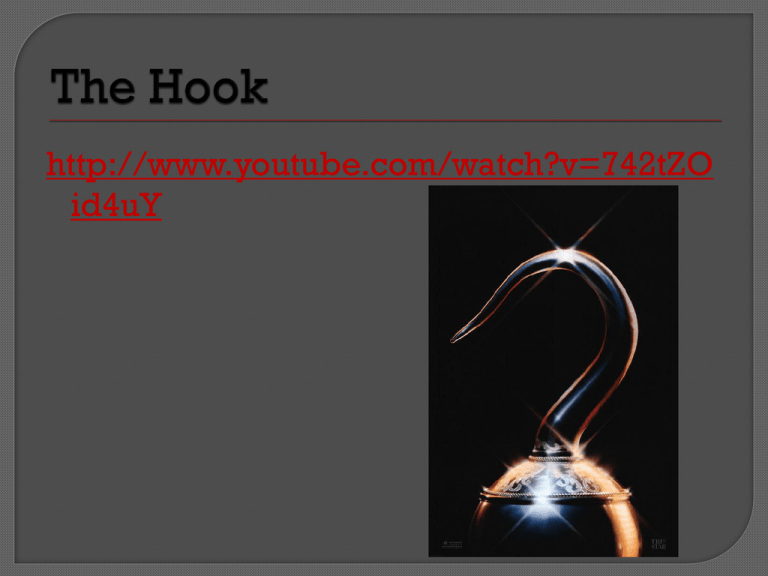
http://www.youtube.com/watch?v=742tZO id4uY Logan Barnes Ricky Diao Doug Wainwright Harrison Scott Czar Nicholas II Ruled as last Russian Monarch 1894-1917 Vladimir Lenin Leader of the Bolshevik party Strong supporter of the working class Utilized propoganda Joseph Stalin Stalin was born in Gori, Georgia on December 2, 1879. Stalin was a sickly child who lived in poverty for his childhood. As a child, Stalin studied for a career in priesthood. Later, he became interested in revolutions around the world. In fact, he was actually put in a cell for reading a book on the French Revolution. Stalin joined the Bolsheviks and was exiled to Siberia. Vladimir Lenin died in January 21, 1924. Following his death, a struggle for the leadership of Russia took place. The two emerging powers were Trotsky and Stalin. Joseph Stalin put his own followers in top political jobs and became leader in 1928. Vladimir Lenin Stalin controlled all aspects of society, in what is called a totalitarian rule. Created several Five-Year Plans, which were put in place to help industrialize Russia. Stalin wanted increased production of everything, especially roads, oil, and steel. Stalin was a firm supporter of propaganda, as he wanted to show the greatness of himself and Russia Controlling common aspects of life, socialist realism enforced to promote the progression of socialist and communist goals Stalin put a command economy in place, meaning the government controlled all economic decisions. Stalin put collectivization in place. Collectives were farms were many farmers lived together, and the government took most of the goods they produced. Stalin feared opposing party leaders, so him and his secret police punished writers, army leaders, and Old Bolsheviks in what was known as the Great Purge. Many of these people were sent to work in the gulags Stalin is infamous for being one of the most ruthless and vicious rulers of all time. Stalin killed twice as many people as Hitler did. Stalin helped to industrialize and modernize Russia. Joseph Stalin and the U.S.S.R had a negative impact on the interwar era. Under Stalin’s Five-Year Plans, Russian citizens had nearly no freedom. Stalin created the first entirely totalitarian state in the world. Stalin was a communist and revolted the idea of capitalism or free trade. Stalin made Russia an industrial nation that produced lots of goods like steel and coal. Stalin and the U.S.S.R had a negative impact on the world in the 30’s. Stalin purged his people and killed millions of innocent civilians. Stalin’s collectivization reduced the production of agricultural goods. The Great Depression had a negative impact on Russia. Overproduction led to a crash in the stock market. Russification, or the act of adopting Russian culture, spread to Ukraine and Poland. During The Ukrainian Genocide, over 6 million Ukrainians were killed by the Soviet Union. http://www.articlesbase.com/politics- articles/russia-in-the-late-1920s-19302905248.html http://www.chennaiads.com/y2kevents/192 0_30.htm http://forums.civfanatics.com/archive/inde x.php/t-32285.html http://wthistory.wikispot.org/Major_Russian _Leaders,_1900-1939

